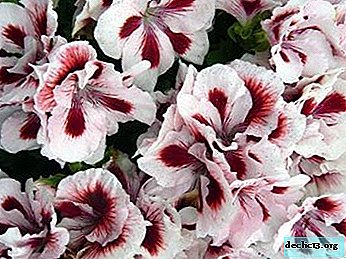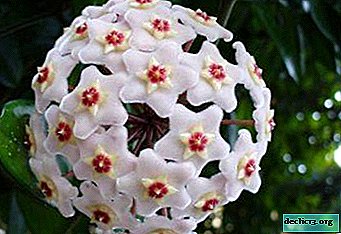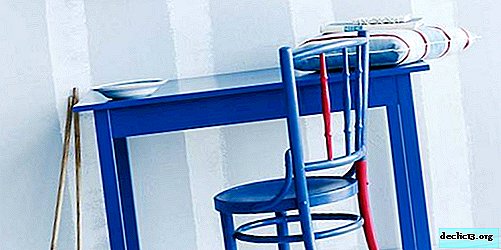How to care for Grandiflora Pelargonium at home?

Pelargonium Grandiflora is one of the most decorative and beautiful representatives of the species of pelargonium. The people call the flower geraniums. In our country, this variety is more common than others.
In the article we will consider the features of the Grandiflora pelargonium. We learn how to care at home, how to properly plant a plant in order to achieve lush and prolonged flowering.
We will also talk about pests and ways to combat them. You will learn how to propagate the plant yourself and how to properly care for it after that.
Description
Grandiflora is a small-sized shrub, strewn with wonderful lush buds during the flowering period. Sometimes this variety is also called English, although the exact place of origin of the variety is still unknown.
reference. In England, Grandiflora is better known as the "royal" variety or "exhibition", in the USA the flower is called "Lady Washington".This plant is valued and loved by flower growers all over the world - primarily for its unusually beautiful flowers - large and lush. Interesting that Grandiflora Pelargonium has no aroma, and the flowering period is reduced.
So, Grandiflora blooms for only three to four months. While most other varieties of geraniums can maintain decorativeness and six months.
Appearance
 The shrub of Pelargonium Grandiflora lignifies with time below, becoming almost a real, albeit compact, bush.
The shrub of Pelargonium Grandiflora lignifies with time below, becoming almost a real, albeit compact, bush.
The leaves of the plant are rounded, with denticles along the edges, have a different color. Colors range from dark green shades to light.
The main attraction of the plant is its flowers. Pelargonium of Grandiflora boasts very large buds.
Note that one flower can reach 6 cm in diameter, which is quite a lot for pelargoniums. The color of the flowers is different: red, purple, pink, as well as all the many shades of these colors.
Flowers are collected in characteristic lush umbrellas, giving the appearance of the plant even more decorative and attractive. The bush reaches a height of half a meter, and grows quite wide.
Interesting. The shape of the flowers resembles pansies, but the diameter is much larger.Grandiflora's inflorescences do not stretch in height, but grow at the level of foliage, which looks very attractive. When the plant blooms, the arrangement of peduncles on the same level with foliage turns the bush into one bright, spectacular ball.
This feature makes Grandiflora a wonderful way to decorate balconies, terraces and interior spaces. Note, however, that the plant is very demanding to care.
In order to get a decorative flowering in this case, you have to try. Next, we consider the main points for the cultivation and care of Grandiflora pelargonium.
Landing
We learn what requirements Grandiflora Pelargonium makes to its place of detention, soil and other nuances.
Lighting and location
 Grandiflora's Pelargonium, like all geraniums, loves well-lit places. However, from direct sunlight on leaves and petals, the plant must be protected. Note that on the windowsills on the north side of the house it is better not to put a pot with this flower - it will not be able to grow well and bloom pelargonium.
Grandiflora's Pelargonium, like all geraniums, loves well-lit places. However, from direct sunlight on leaves and petals, the plant must be protected. Note that on the windowsills on the north side of the house it is better not to put a pot with this flower - it will not be able to grow well and bloom pelargonium.
In winter, the plant needs additional lighting. It can be organized using an artificial light lamp. If additional lighting is not provided in winter with a short natural daylight in the summer, pelargonium will not be able to please with spectacular decorative flowering.
The lack of light affects the appearance of Grandiflora's pelargonium as follows:
- buds become small;
- shoots are extended in length, violating the compactness of the bush;
- the foliage is thinning and turning pale.
Temperature
Pelargonium Grandiflora prefers to grow at a moderate temperature. So, in the summer the plant can tolerate heat up to +25 degrees, and in winter a cooler temperature is best - about + 12-17 degrees.
Soil composition
For the pelargonium of Grandiflora, a purchased substrate intended for geraniums is ideal. All components in this substrate are already selected in the most optimal way. However, if you wish, you can prepare the land yourself. To do this, you need to take the following components in the specified proportion:
- 1 part of turf;
- 1 part peat;
- 1 part humus;
- 1 part of river sand (middle fraction).
It is important not to forget to put a layer of drainage in the form of expanded clay or small bricks at the bottom of the pot.
Care Features
Find out the main points to care for this royal flower.
Watering and loosening
 Pelargonium Grandiflora irrigation requires abundant and regular. It is important, however, to prevent waterlogging of the soil, since this is fraught with decay of the roots of the plant.
Pelargonium Grandiflora irrigation requires abundant and regular. It is important, however, to prevent waterlogging of the soil, since this is fraught with decay of the roots of the plant.
Moisten the soil only if the topcoat has dried up. As for the quality of moisturizing, in this case you need to use soft, settled water for irrigation.
If you notice that pelargonium suddenly began actively and almost instantly after their appearance to drop inflorescences, it means that the soil is waterlogged. In this case, it is important to hold off with the next watering until the moisture level is normalized.
If the foliage begins to dry and turn yellow for some reason, then it is most likely a lack of moisture. In this case, on the contrary, more often water your pelargonium. Note that the lower the air temperature, the less the plant needs watering.
Attention. Grandiflora does not like spraying: when moisture gets on her petals, ugly spots and stains appear on the latter, spoiling the decorative shrub.Loosening the soil is recommended after watering, but not more than once every 2-3 months.
Top dressing
Before the flowering begins, Grandiflora's pelargonium needs nitrogenous fertilizers and with a calcium content. After the inflorescences begin to form, it is recommended to stop fertilizing with nitrogen so as not to cause the plant to grow rapidly in greenery to the detriment of flowering. Note that it is important not to overfeed Grandiflora, because with an excess of minerals the leaves of the plant turn yellow.
Pruning
So that the bush is dense and compact, it is recommended to pinch the growing shoots in time. Thus, there will be more rapid lateral branching, as well as more magnificent flowering. Dried inflorescences must be removed without fail, since in the presence of dry buds the formation of new ones stops. Pelargonium Grandiflor needs to be cut off only in the fall.
 The pruning procedure carried out in the spring will deprive the shrub of most peduncles. At the same time, all shoots from the bush should not be cut off, as this will be too traumatic for the plant.
The pruning procedure carried out in the spring will deprive the shrub of most peduncles. At the same time, all shoots from the bush should not be cut off, as this will be too traumatic for the plant.
If there are a lot of shoots, trim in several stages. In this case, it is necessary to maintain the distance between the steps per month.
It is important to know that a plant does not like transplants. That is why an adult bush formed without special need is better not to "turn over" once again.
Diseases and Pests
Note that this plant is very susceptible to disease, is sensitive and has delicate, delicate health. Usually all problems with well-being occur in the pelargonium of Grandiflora due to improper care. Exactly these harmful insects and diseases pose the greatest danger to Grandiflora.
- So, if the owner of the flower neglected before planting with disinfection of the soil, a black leg and late blight are likely. These dangerous rot can quickly completely destroy the plant.
- Gray rot is also dangerous for the plant. This disease manifests itself as a specific type of uneven spots on the leaves. You will have to get rid of the disease with the help of a systemic fungicide or copper sulfate. And to prevent this disease, it is important to exclude excessive watering of geraniums.
- As for pests, most often Grandiflora is affected by a spider mite and whitefly. If these insects or their larvae are found, be sure to treat the plant with an insecticidal solution. In addition, it is also necessary to thoroughly wipe the leaves of pelargonium in order to remove larvae and eggs of pests from them.
Breeding
Pelargonium Grandiflora is best propagated vegetatively. At home, this is the most logical and easiest way. For breeding, spring or summer time is best suited.
Brief instruction:
- The first step is to cut off the apical shoot from the mother flower.
- Fill the place of cut with activated powdered charcoal, and wrap the stalk in paper. Thus, the stalk should spend a couple of hours, having dried out a little during this time.
- In the prepared soil (peat + sand) plant the cuttings, moisten the soil a little.
- From above it is recommended to cover the container with plastic wrap to create a wet greenhouse effect.
Important: In water, it is better not to grow roots, as they often rot in this way.
- Under the film, the earth must be periodically sprayed from the spray gun. After about 3-4 weeks, the shoot will take root in the ground.
- After rooting, the stalk can be transplanted into a permanent pot. A plant can bloom in the same year in the summer (subject to spring planting).
Conclusion
We met such a wonderful ornamental plant as the Grandiflora Pelargonium. As you can see, along with exceptional external decorativeness, the plant also has a rather capricious character, it is very sensitive to care and features of the content.
Therefore, if you want to enjoy the flowering of the royal pelargonium for a long time, you must carefully observe all the main points of care, carefully monitor the well-being of the flower, taking timely measures to prevent and protect, eliminate diseases.

















